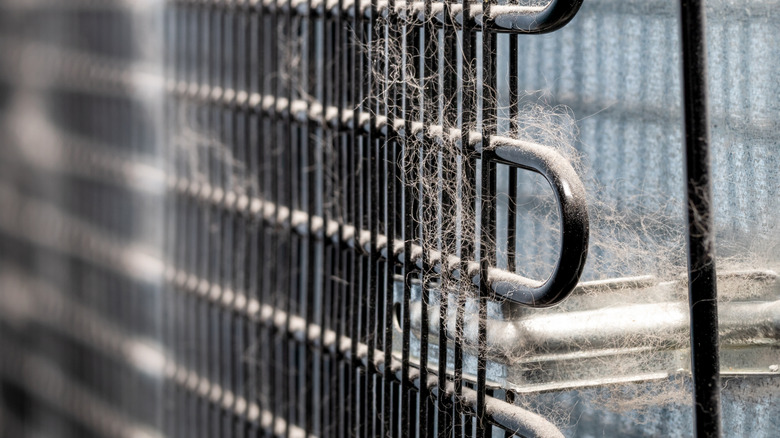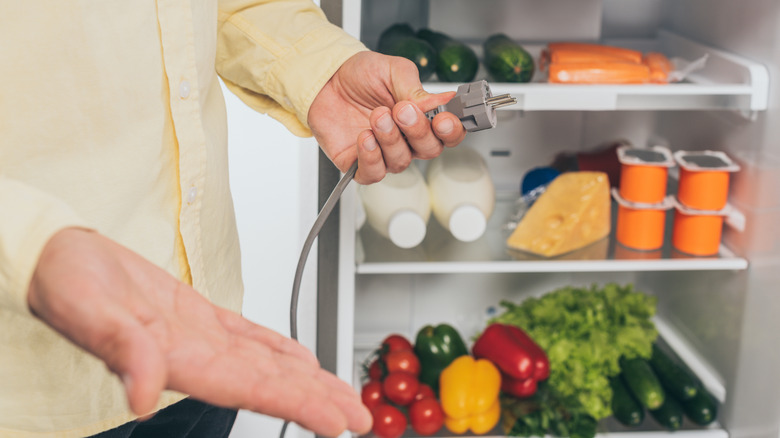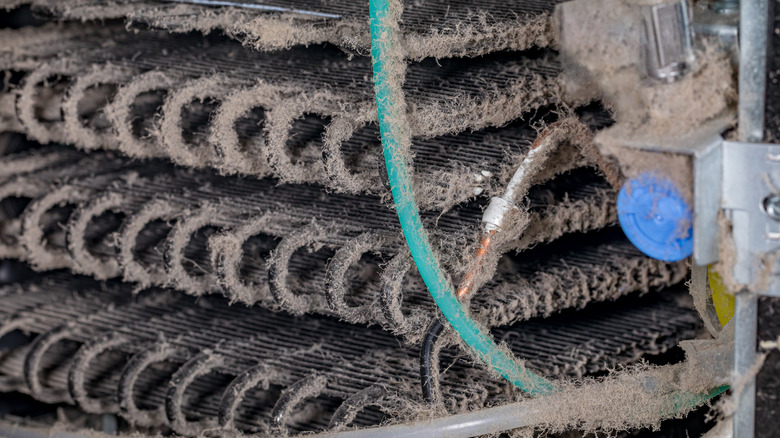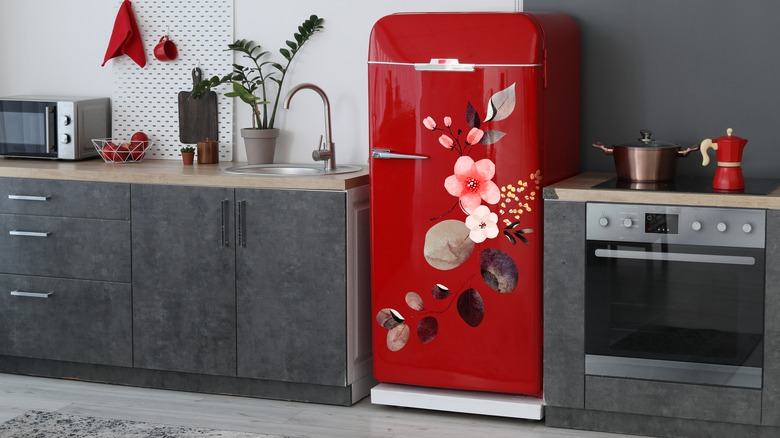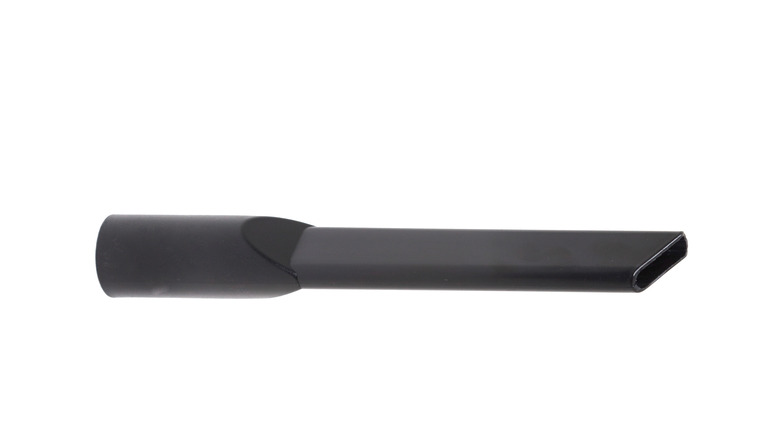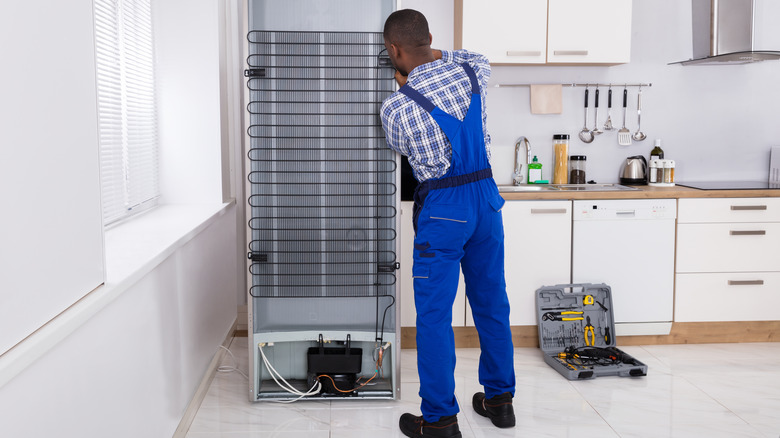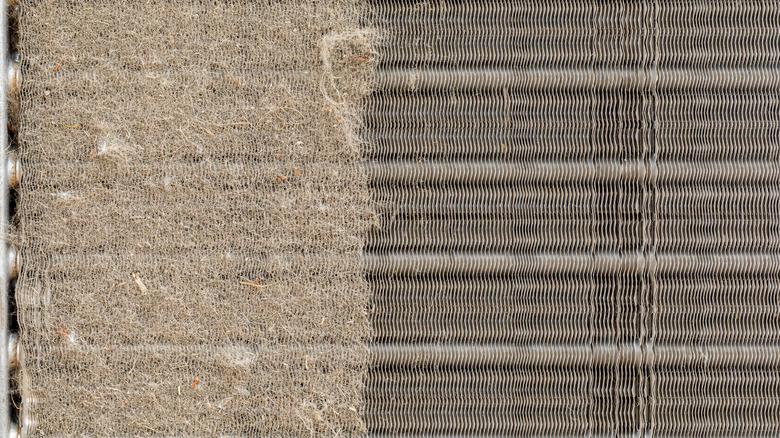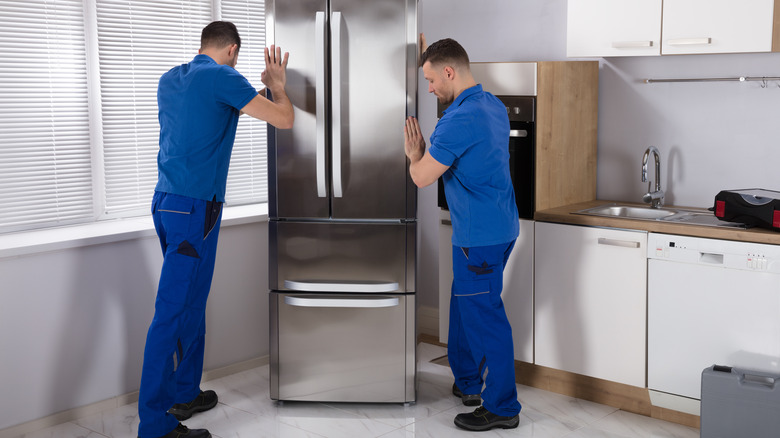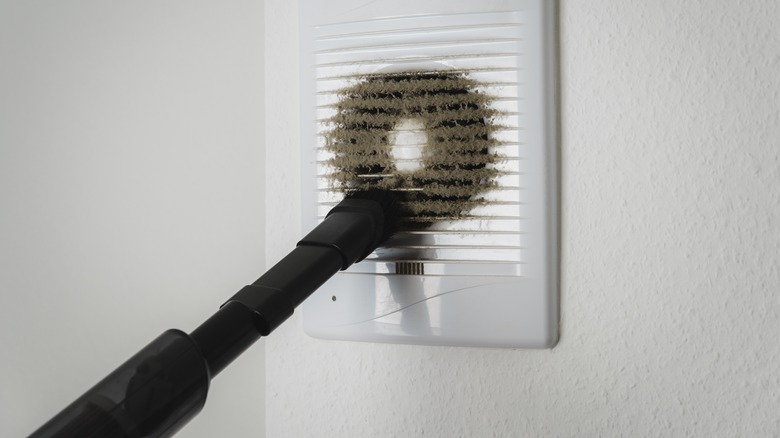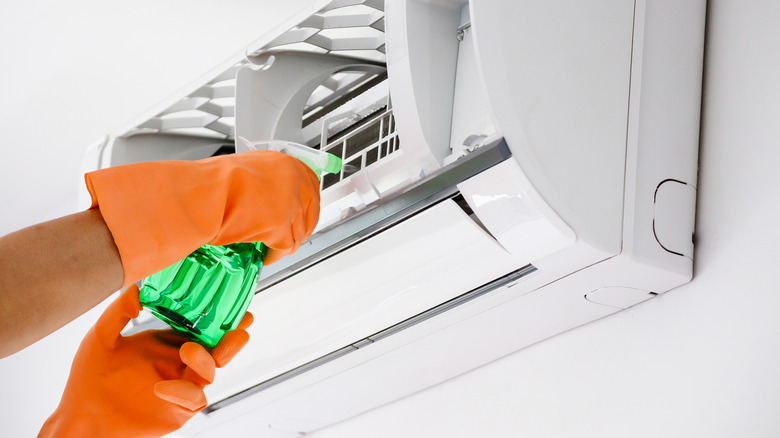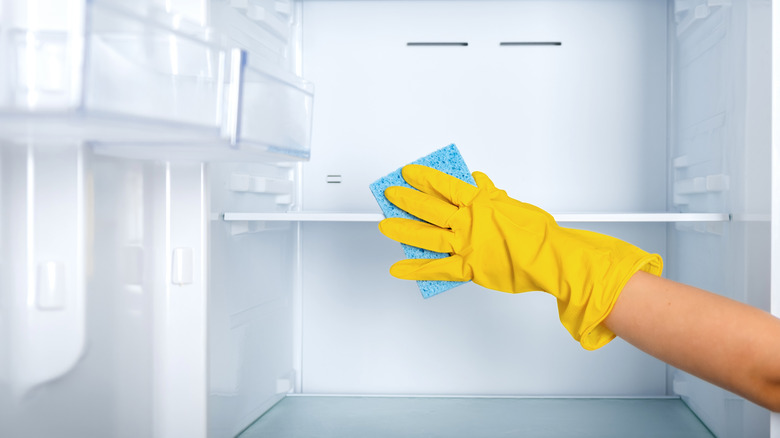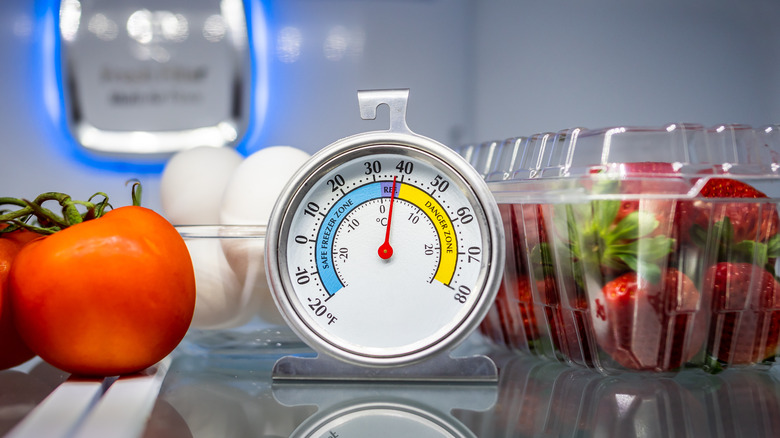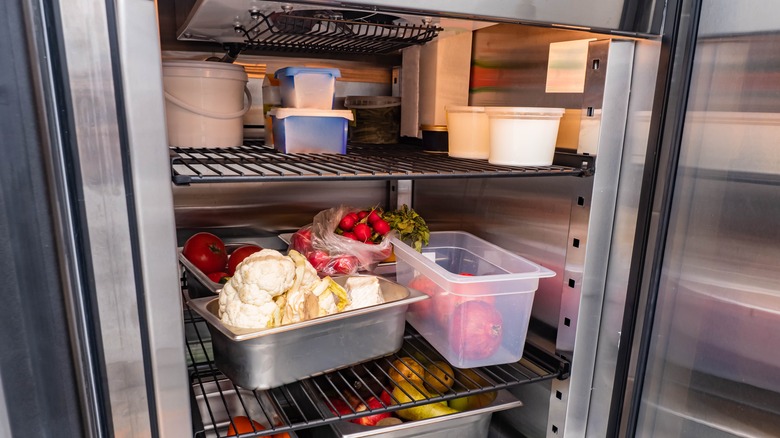The Best Way To Clean Refrigerator Coils
Refrigerators are among the many things we take for granted. Remember when you spent $15 on ingredients to make a "healthy" version of Coke? It went straight into the fridge, with other immediate regrets like that kale salad, kale chips, and (shudder) kale smoothie, and you never had to think of them again. Where would we store all those kale creations and trendy TikTok beverages without modern refrigeration?
But when there's trouble, it sometimes creeps in slowly, so you don't really notice what's happening. You want to show a friend just how interesting that White Claw glitter slushy is, but it seems just a tad warmer than a few days before. And your power bill keeps edging upwards, cutting into your whipped coffee budget. What's going on here?
It could be that your refrigerator's condenser coils, a heat exchange mechanism critical to proper kale cooling, have gotten dirty. This will cause warmer temperatures, higher electric bills, and eventual refrigerator failure. The good news is that this is a quick fix, according to Amana and most other manufacturers. Gather your cleaning tools (usually just a vacuum and a brush ... more on that in a minute), flashlight, and dust mask. Some cautious types also recommend gloves and eye protection. Let's get started.
Let's get started
First things first: Consult your refrigerator's owner manual for guidance and gotchas specific to your model. If you have lost that box of paperwork about how to avoid starting a fire with your blender and how to clean your fridge coils, we have links to most refrigerator manuals below.
You might find that your model doesn't require cleaning at all, according to Eugene Smith of How To Fix It, and some companies say you don't have to clean their models regularly (via Amana). If yours does, like a toddler's hair, require a good brushing every six months, what you'll need is a vacuum cleaner with a long, pointy attachment and a soft brush, preferably also long and pointy. With gathering your tools and consulting your manual out of the way, it's time for the first step: disconnecting power from your fridge.
If unplugging the fridge is impossible, you can also flip off the circuit breaker servicing the fridge. The right breaker shouldn't be difficult to find, and many refrigerators will be on their own electrical circuit, says Mr. Electric, who should know. But always check to make sure you're turned off power to the right thing. You don't want to discover the hard way that your circuit breaker panel is mislabeled. You might also need to disconnect a water line (via the Sam Houston Electric Cooperative); in any event, take care throughout this process not to crimp the water line.
Find the grille and make sure you can get to it
Hang on ... before you get started, you need to take the initial step of figuring out where your condenser coils are. According to GE, the coils are typically at the top, bottom or back of the fridge. This doesn't eliminate much other than the vegetable crisper, so let's look at the location on a few popular brands. Most manufacturers, such as LG (via Maughanster Appliance Repair) and Bosch, place the coils at the back or underneath, behind the toe kick. KitchenAid coils are at the bottom, while GE Monogram (via Appliance Genie), Sub-Zero (via Wilshire Refrigeration & Appliance), and many built-in refrigerators have their coils at the top, per Desertech. Samsung coils can be in any of these locations (via Appliance King of America).
The location of your coils might require you to move the fridge out from a recess or cubby area, particularly if they're on the back or if you have a built-in model. Give yourself as much room as necessary to work thoroughly. There's no point in compromising before you even get to step one. Do not tilt the refrigerator unless you have to, and if you do, consult manufacturer guidelines about how long to leave it upright before plugging it back in (via GE).
Step one: remove the grille covering coils
If there's a grille covering your condenser coils — there usually is unless they're mounted on the back of the fridge — your first step is to remove the grille. This is where your manual is worth its weight in Bitcoin, because there's no good way to generalize about grille removal. Some models are screwed on, but most clip in place.
Amana says you accomplish this by "opening both doors, placing your hands along the ends of the grille and pushing in on the top of the grille while pulling up on the bottom," which is the same guidance Maytag and Whirlpool offer. Sharper Service Solutions says that you remove the grille on a KitchenAid fridge by opening both doors and "place one hand on each side of the grill, push down on the top of the grill and pull up on the bottom at the same time." We assume it's a motion similar to the Amana instructions.
According to Warners' Stellian, using a wiggle-and-pull is a universal strategy. Indeed, this method works for fridge grilles, spark plug wire removal, fishing with artificial lures, and retrieving an intractable tape measure or chihuahua. You don't get more universal than that. If you pull too hard and break the grille, it's possible that yours was secured with screws. Go back in time and remove the screws first, or simply check for them before you start tugging.
Step two: vacuuming the coils
At last, we arrive at step two, vacuuming the coils, which you might have misinterpreted as a dreampop band name. If you located your refrigerator manual way back in step one, you might have seen warnings like "can only be cleaned by a certified technician" (via Maytag). What technical wizardry do these technicians wield, you might wonder? LG recommends cleaning by a professional "to avoid personal injury," and while they surely mean no offense to hobbyist refrigerator technicians, personal injury is no joke. What Indiana Jones-like feats of coil-vacuuming daring could result in injury? What sort of athletic body control is required to save you? What skills let the pro cleaners get home to their families every night? And how personal are we talking about?
Turns out, it's mostly vacuuming and brushing. The very second thing you'll do when cleaning your refrigerator coils is to vacuum in and around the coils as well as you can, reaching every possible point from every possible angle. This will clean away all the loose dust and debris, leaving you with an unobstructed view of the next danger: brushing.
Step two, the sequel: brush, repeat
So, your freshly vacuumed coils somehow still look like the grease trap at a long-forgotten, divided highway Waffle House. Here's where your tool choice would come home to roost, if tools were birds and metaphors made any sense at all. Amana says the goal is to clean the coils, the area behind the coils, and the "front surface area," which is unclear, but we can assume they mean to clean everything near the coils. It's important to have a brush long enough to reach everything, yet soft enough to avoid damaging the coils. It also should be stiff enough to clean away the more challenging grime that came from ... well, no one knows where it comes from, except when it comes from pets (via Warners' Stellian).
The idea of the brushing is to either dislodge or loosen any dirt and grime so that it can be finally removed by vacuuming (via DeserTech). Realtor.com recommends holding a vacuum under your brush as you clean to catch any falling bits of dirt. If you have particularly stubborn or greasy stuff on your coils, you might consider applying a cleaning solution, but this is not necessary under most circumstances, and it can hinder vacuuming effectively. So, brush, vacuum, repeat. That's it. The trick is to get all the way around every part of the coils, and to clear any adjacent open spaces that are no longer open.
Step three: secure the grille
To say that replacing a grille is simply taking it off in reverse ignores the First Law of Children and Entropy or Something, which states that dismantling any system into its component parts, no matter how difficult, is immeasurably easier than reassembling it from an undifferentiated pile of screws and fragile faux-stainless plastic squiggles. If you're lucky, your grille snaps on like most, which at least minimizes the mysterious pile of leftover fasteners you end up with.
Sometimes you need to look for installation instructions, rather than use and care instructions, or general use instructions, as is the case with some Viking and Dacor models. This is likely to be true if the manufacturer doesn't want anyone to get hurt by cleaning the coils themselves. Vacuuming injuries are apparently not rare. CleanLink describes the common injuries as strains throughout the arms and lower back. The motions used can be responsible for giving cleaners carpel tunnel syndrome.
If you're having particular trouble, you might want to look online for a video with a solution. Any task that has ever been easy, difficult, or anywhere in between has been documented by a YouTuber in a 20-minute video with at least 30 seconds of useful information. Try searching for your refrigerator manufacturer and model number.
Step four: put it back where you got it
Rolling a refrigerator 3 feet gets a whole step of its own because nothing is ever as simple as it sounds. The first step of step four is probably plugging the fridge back in (or turning on the circuit breaker), which probably means that moving the refrigerator back into power receptacle range is the pre-first-step step of Step Four.
There's nothing mysterious, or particularly difficult, about putting the fridge back where it came from. You'll want to keep in mind any manufacturer guidance about tilting your fridge. If your process took longer than expected, note that the CDC (in a handout with a peculiar fixation on chicken livers) says you should discard food left unrefrigerated for more than two hours, and helpfully advises that you "never taste food to determine if it is safe to eat." Also, never burn down your house to see if your house will burn down.
It is always a good idea to be gentle with exposed parts; don't roll over the power cord, don't twist or crimp your water supply line, if there is one; and if your refrigerator has external coils on the back, don't jam them into the wall full-speed. (Aside from potentially damaging the coils, you need to leave space between the coils and the wall for the fridge to cool properly, via Appliance Repair Specialists.)
Indispensable tool: coil-cleaning brush
Let's take a look at where you can find the things you need to get this job done. Assuming you already have gloves and mask, we'll look at brushes first. What you need is a soft, long, pointy brush that can remove grime without also removing your coils. Amazon sells a number of such brushes, most of which are advertised to serve multiple purposes, often including cleaning dryer vents.
You can also find brand-specific coil-cleaning brushes (for example, for Whirlpool, GE, and Frigidaire refrigerators). Any brush advertised for the purpose should do the trick (but check the reviews), so manufacturer-made brushes might be unnecessarily expensive.
Some such brushes attach to vacuum cleaners, which might be a reasonable idea, but use caution with anything overly aggressive. The Samsung Spinning Sweeper Brush might be fine, but be careful, as you don't want to damage the coils. The same goes for anything with a wire brush. And whether it works well or not, the thing about the Buff Brite Fur-Eel PRO & Fang Combo Kit is that it has a great name you can invoke occasionally: "Honey, where's Mr. Nozzle? I'm going to break out the Fur-Eel and clean the fridge coils."
Dispensable tool: store-bought cleaning solution
Liquid, aerosol, and foam cleaners are probably not necessary for most non-commercial coil-cleaning jobs; the brush and vacuum are usually sufficient. But if you have an unusual amount of stubborn buildup, or if you're just an obsessive completist, you can either make a cleaning solution yourself or buy a commercially available one.
DIY coil cleaners are pretty simple and tend to be built around vinegar and rubbing alcohol. Tips Bulletin has a recipe for a three-ingredient coil cleaner that's probably about as simple as you can get while actually removing dirt. Carrier recommends a simple solution of detergent and water for cleaning HVAC coils, though it's possible they aren't soiled with gunk quite as stubborn as the stuff you'll find in kitchens where cooking oils might be involved. Note that refrigerator coils can be made of copper, and that vinegar (as well as bleach, hydrogen peroxide, and ammonia) will corrode copper (via Powers Scientific).
If New Year's Eve 2019 still has you squeamish about mixing things, you can buy coil-specific cleaners from Amazon, Lowe's, Home Depot, and Walmart.
Other tasks you can accomplish
Maintenance tasks are often best grouped together; once you're getting under the hood, might as well check everything. There are many recommendations for other chores you can accomplish while cleaning your refrigerator coils. Certainly, you should clean your grille while you have it off the fridge, and Tips Bulletin recommends an overall cleaning. How To Fix It has a number of specific recommendations, including cleaning your condenser fan (if you have one), door gaskets, freezer vent, and drip openings. Whatever drip openings are, it sounds like they should be kept clear, or possibly never thought about at all. Note that the How To Fix It guidance is specifically for Whirlpool fridges, but applies to many other brands, as well.
Moving a refrigerator is an onerous enough task that you might not do it regularly, which means that all manner of unpleasantness could await you underneath and behind it. Miss Spotless pinpoints this area as a source of allergens and odors, and recommends soapy water or vinegar and water, except where mold is found, in which case you should use a bleach solution.
Be on the lookout for...
While you're under the hood, there are also a few things you should check out to make sure everything is running, and continues to run, in top form. The most important is probably to check that your coils aren't too hot. According to Home Repair Geek, the coils should be warm but not hot to the touch. The same is true of the motor (via All Tech Appliance); it should be warm, not hot. An overheating compressor can be a fire hazard, so this is something to take seriously and act on immediately (via Fix Appliances).
If you roll out your fridge and find water on the floor, this is obviously an emergency on several levels. It could indicate something like a blocked or leaking water line, a blocked drain line, a bad door seal, poor cooling leading to condensation, or an un-level fridge. It can also, of course, cause expensive damage to your floors.
Finding your refrigerator manual
We tracked down links to the manuals download pages for every refrigerator manufacturer listed in RefrigeratorPro's list of manufacturers. You'll find the information you're looking for in different places depending on the brand: installation manuals, owner's manuals, use and care manuals, stuff you should pay a technician to do manuals, and so on.
Norcold (primarily RV refrigerators)
What about commercial models?
Commercial refrigerators are ridiculously expensive, ridiculously expensive to operate, and ridiculously expensive to maintain and repair. They also do a ridiculously good job of cooling down fast and making sure food stays at safe temperatures. Well, they usually do that. But a commercial fridge with dirty coils is like any other in that it doesn't cool well, and in this case can make restaurant goers (or affluent homeowners with a taste for stainless steel) sick.
Commercials fridges are designed to handle a large load, but their capacity and design means that they also tend to gather more dirt and debris, according to Commercial Fridge Repairs. And if you don't want a $2,000 consumer fridge breaking down early, you certainly don't want a $5,000 commercial refrigerator quitting on you prematurely.
Commercial fridge owners might also have a few additional maintenance items to deal with, such as cleaning evaporator coils (not usually necessary with consumer models), and cleaning condenser and evaporator fan blades.
Cleaning cheat sheet
The Big Refrigerator powers-that-be would have you leave coil cleaning to a professional appliance technician. But, if you stubbornly refuse to let the secret realm of vacuums and brushes be dominated by a cabal of bored Maytag repairmen, here's all you need to remember to get the job done.
Remove your food to a cooler, unless you can get the job done very fast. Find your manual to see if it says anything useful about coil cleaning. Move the fridge out so you can access it properly. Unplug your fridge (or turn off its circuit breaker) and disconnect the water line, if there is one and if it's necessary. Remove the grille, if you have one. Vacuum the coils so you can see what you're doing, then brush and re-vacuum them as necessary. Apply cleaning solutions if it helps. Replace the grille, then plug the fridge back in and move it back into place. When your refrigerator interior is again below 40 degrees Fahrenheit, you can replace the food and pretend none of this ever happened.
Michael Jordan might have gotten better as a result of his failures, but it's unlikely your fridge is going to take its problems as motivation to become the coolingest refrigerator of all time. If you are cleaning your coils because of a specific cooling problem and cleaning the coils doesn't help, Samsung has some tips you can try to restore proper cooling.
